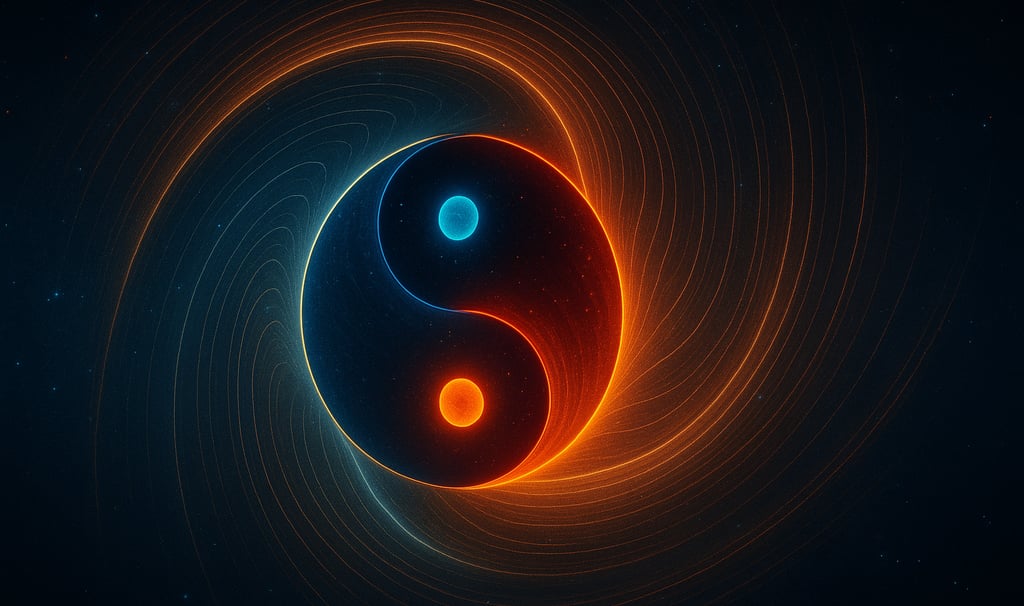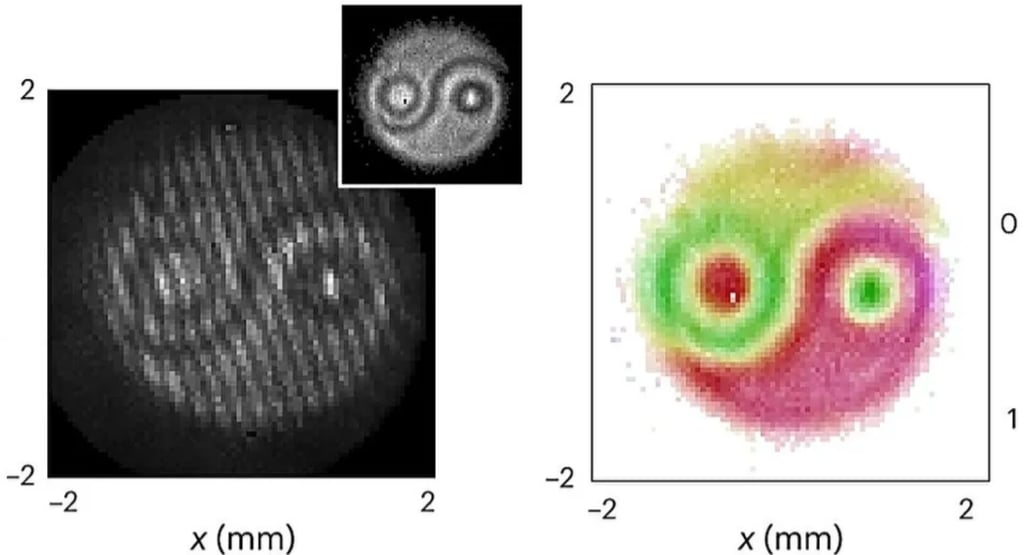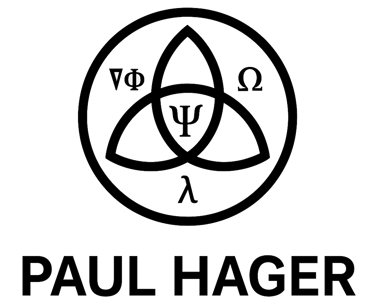The Yin-Yang Field — How Tension Shapes Everything from Matter to Mind
Discover how the ancient symbol of yin and yang reveals a fundamental law of the universe. This article reframes yin and yang as universal field dynamics—where tension constantly flows between absorption and projection. Explore how this timeless rhythm shapes matter, emotions and even your everyday decisions, offering a fresh, scientific perspective on life’s hidden balance.
POPULAR
Paul Hager
7/7/20258 min read


Introduction — Yin and Yang as Field Dynamics
Few symbols are as instantly recognizable as yin and yang. The black and white swirls, locked in a seamless dance, evoke ideas of opposites—light and dark, masculine and feminine, active and passive, movement and stillness.
But beyond this familiar image lies a far deeper reality. Yin and yang are not fixed states, nor are they simple opposites. They are dynamic forces—two fundamental ways in which tension behaves within a field. Together, they describe how everything in existence flows, shifts and seeks equilibrium.
Within the framework of the Hagerveld—the foundational field of pure tension from which matter, space and time emerge—yin and yang gain an unexpected new significance. They are revealed as fundamental directions of tension within the field itself.
Yin is the force of absorption, drawing in and consolidating tension. Yang is the force of projection, releasing and radiating tension outward. They are not rivals, but complements: yin gathers what yang disperses, and yang moves what yin holds.
This article explores how yin and yang naturally emerge from the field dynamics of the Hagerveld, shaping everything from physical matter to emotional states, from galaxies to living cells.
Seen through this lens, yin and yang are no longer mystical abstractions. They become clear, precise terms for describing how the universe works—not as myth or metaphor, but as direct field science.
2. Noohedral Translation — Yin as Field Absorption, Yang as Field Projection
In the Hagerveld, there are no fixed objects or static forces. Everything is field, everything is tension, everything moves. Matter, space and time arise from the ceaseless play of tension, where some areas condense and others expand.
One striking principle emerges: tension always flows in two complementary directions.
One direction pulls tension inward, drawing it together, holding it in place.
The other pushes tension outward, releasing it, propelling it forward.
These two flows are precisely what ancient traditions have described for centuries as yin and yang.
In the Hagerveld, yin represents field absorption. It is the field’s capacity to pull tension inward, bind it and stabilize it. Yin creates cohesion, allowing forms to endure. Without yin, everything would scatter and dissolve.
Yang represents field projection. It is the field’s capacity to push tension outward, set it in motion and radiate it through space. Yang initiates change, drives motion and stirs circulation. Without yang, everything would stagnate and freeze.
Within the Hagerveld, yin and yang are not adversaries. They are fundamental processes of field dynamics:
Yin gathers, stores and organizes tension.
Yang releases, moves and directs tension.
This interplay governs everything—from the formation of matter to the unfolding of space and time itself.
Here, no value judgment applies: yin is not superior to yang, nor is yang superior to yin. Both are essential. Without yin, there is no structure. Without yang, no motion.
Through this perspective, yin and yang are revealed not as mystical or esoteric forces, but as the most basic description of how tension naturally flows in every aspect of reality.
3. Tension and Circulation — How Yin and Yang Drive Field Loops Together
At the heart of the Hagerveld lies circulation. Tension doesn’t simply travel from point A to point B—it moves in cycles, loops and spirals. Everything that endures revolves, sometimes slowly, sometimes at unimaginable speed.
Yin and yang together form the engine behind these circulations.
Yin pulls tension inward. It builds tension, holds it, concentrates it.
Yang pushes tension outward. It propels tension, sets it in motion, releases it.
When these two forces meet in the field, a loop is born—a circulation where tension is continuously absorbed and radiated. This isn’t a static pattern, but a living stream where yin and yang endlessly alternate.
Within such a circulation, you can clearly see the field’s behavior:
At one phase, yin dominates—tension contracts, the field condenses and structure emerges.
At another phase, yang leads—tension is released, energy flows and movement resumes.
This perpetual exchange creates a breathing balance. The field inhales and exhales: tension is gathered, released, gathered again.
This is not a metaphor or poetic image, but a precise description of how tension behaves in every stable system—from atoms to planets, from molecules to living cells.
Without yin, the field would disintegrate into scattered fragments of energy.
Without yang, the field would suffocate under its own weight and stagnation.
Every stable form—every spinning planet, every coherent atom, every living cell—exists because of this constant exchange:
Yin collects and consolidates tension.
Yang discharges and circulates tension.
This is the Hagerveld’s continuous dance. It generates not only structure but also change and movement—all in unending circulation.
Once you see this, it becomes clear: yin and yang aren’t abstract philosophies or “energies.” They are the simplest terms for the universal rhythm of tension, present in everything that exists.
4. Matter and Formation — How Their Balance Creates Stable or Unstable Forms
Everything we perceive as “solid”—stones, trees, bodies—seems fixed and unyielding. But within the Hagerveld, matter is nothing more than a temporary tension pattern. There is no static substance, no hard core, only a circulation of tension so perfectly balanced that it appears as a solid form.
The secret behind these stable forms lies in the balance between yin and yang.
When yin and yang are in perfect equilibrium, a pattern emerges that neither collapses nor stagnates. Tension flows smoothly in a loop:
Yin holds and stabilizes the tension, keeping the form from falling apart.
Yang keeps the tension moving just enough to sustain vitality.
This creates a structure that feels firm yet remains in constant motion—like a flame that maintains its shape as long as the fuel keeps flowing.
However, when the balance tips, everything changes:
Too much yin? The tension thickens and clumps. The form becomes heavy, sluggish and rigid. It may harden, block or even collapse under its own weight.
Too much yang? The tension rushes too quickly. The form destabilizes, disintegrates or bursts apart, leaving behind only a cloud of scattered energy.
The stability of a form doesn’t depend on its size, strength or mass. It depends entirely on how tension circulates within it. Forms arise when yin and yang sustain a self-supporting loop. Forms dissolve when that loop falls out of balance.
This principle applies universally:
In atoms, where electrons orbit nuclei in stable tension patterns.
In planets, which remain in orbit through the balance of attracting and repelling forces.
In living beings, where yin and yang govern the cooperation of organs, cells and energy flows.
Matter is nothing more than a momentary pause in the flow of the field—a resting point in an endless stream of tension.
Once you grasp this, it becomes clear that nothing is ever truly “solid.” Everything visible exists only as long as yin and yang continue their dance of tension in balance.
And the moment that dance falters, the form dissolves back into the field.
5. Field Balance in Daily Life — What It Means for Our Bodies, Emotions and Choices
The tension dynamic of yin and yang isn’t limited to stars, planets or atoms. The same field dance flows through our daily lives, our bodies and even our minds.
Our body is a moving field—a bundle of tension constantly absorbed and released. Every organ, every muscle, even every thought arises from the gathering and releasing of tension.
In the body, yin represents everything that absorbs and stores tension:
Rest, recovery, sleep, nourishment, tissue repair, silence.
Yang is everything that releases and projects tension:
Movement, action, speech, muscle activity, heat, expression.
When these forces remain in balance, we feel both stable and vibrant.
We have energy to act and the calm to recover.
We can think without overthinking, feel without being overwhelmed and act without burning out.
But when the balance shifts, tension either builds up or scatters:
Too much yin? We feel heavy, sluggish, tired, stuck, melancholic or emotionally blocked.
Too much yang? We become restless, nervous, impulsive, irritable or drained.
Even emotions follow this field pattern:
Yin emotions draw us inward: sadness, fear, shame, guilt. They invite reflection and integration.
Yang emotions push us outward: anger, joy, pride, excitement. They drive action or outbursts.
This same field also shapes our decisions:
Choices born from calm and clarity usually arise from a well-balanced tension field, where yin and yang cooperate smoothly.
Choices made from panic, compulsion or apathy often result from disrupted tension patterns, either holding too much or losing too much at once.
Once you recognize this field perspective, daily life becomes transparent:
Everything you feel, think or do is a play of tension—a constant dance between holding and releasing, yin and yang.
And the most empowering insight:
This field isn’t something you merely endure. It’s something you can learn to sense and even guide—not through struggle, but by consciously listening to what the field calls for in each moment: rest or movement, intake or expression, yin or yang.
6. Illustration — Yin and Yang as a Visible Field Pattern
Remarkably, the yin-yang principle isn’t limited to symbolism or abstract field models. It has now been observed in experimental physics. The image below comes from a scientific experiment involving two entangled photons forming a shared field pattern. Using a technique called biphoton digital holography, researchers visualized their combined wave function.
The result? A direct circulation of tension that precisely mirrors the yin-yang pattern:
The dark region (yin) absorbs and holds tension.
The light region (yang) projects and radiates tension.
Together, they form a closed loop—perfectly reflecting the field principle of absorption and projection.
This experiment reveals exactly what the field model of the Hagerveld describes:
Tensions in the field can organize into visible circulations of yin and yang, as long as coherence remains strong enough.
What appears here on a quantum scale is, in fact, the same universal principle that governs everything—from atoms to galaxies.
This image isn’t just a scientific curiosity. It’s visual proof that yin and yang are not philosophical metaphors but real, measurable expressions of how tension circulates throughout the universe.
7. Conclusion — Yin and Yang as Primordial Forms of Field Tension in a Modern Field Perspective
Yin and yang are often regarded as ancient concepts from a distant, mystical past—symbols of Eastern wisdom tied to spirituality and philosophy. But seen through the lens of field dynamics, they reveal something far more fundamental: not old folklore, but a precise description of the universe’s core mechanics.
In the Hagerveld—where everything consists of tension and circulation—yin and yang emerge as the primal movements of the field itself. Together, they represent the most basic mechanism of all existence:
Yin, the force that absorbs, holds and concentrates tension.
Yang, the force that releases, moves and directs tension.
Every phenomenon, from subatomic particles to entire galaxies, flows between these two poles. Everything circulates, everything emerges and dissolves through this interplay of absorption and projection—of inward focus and outward expression.
What once appeared as a symbolic balance between opposites now stands revealed as an exact physical principle—measurable, demonstrable and universally active. Yin and yang are no longer abstract spiritual ideas but concrete directions of field tension, visible in every layer of existence.
They demonstrate that stability and change are not in conflict—they are two sides of the same current. Matter isn’t fixed—it is simply a momentary balance between gathering and releasing tension. Even space and time are not separate from this field dynamic—they arise directly from it.
In the modern field perspective, yin and yang retain all their potency—yet now they shine with greater clarity than ever before: as the simplest terms for the deepest mechanism that keeps everything in motion.
And once you see this, it becomes clear:
Yin and yang aren’t ancient relics. They are timeless.
They are the field itself.


